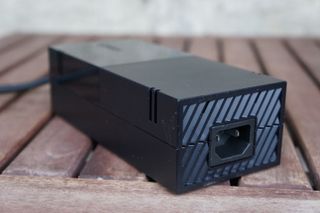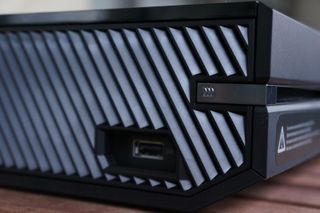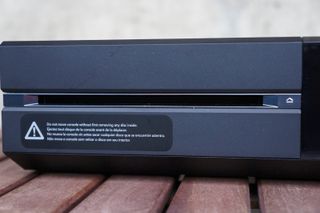Xbox One Review: Unifying Your Living Room Experience
We've been messing with Microsoft's Xbox One for a while now, and it's surprisingly hard to compare against Sony's PS4. Join us as we walk through the hardware, the software, and the console's role quarterbacking your more connected living room.
Power, Internal Storage, And Game Installations
Power Brick

The Xbox One's power supply is external, separate from the console. Of course, that adds one more bulky piece of hardware on the floor, which is going to affect some people more than others. In comparison, Sony's smaller PS4 employs an integrated PSU.
It sounds like a one-sided debate, but there are positive and negative reasons you'd want one configuration or the other. Should the power supply go out, replacing Microsoft's unit is going to be much easier than Sony's. Also, getting the PSU's waste heat out of the chassis helps simplify thermals. But then there's the elegance of a built-in power source that doesn't need to be factored into where the console sits or how its wiring is routed. From a user-facing perspective, and when everything is working properly, the integrated PSU is almost always preferable.
Storage
The Xbox One comes with a 500 GB hard drive. Compared to the highest-end Xbox 360's 20 GB drive when that console first shipped, we're looking at a very significant step up in capacity. Of course, that's also commensurate with the storage demands of today's titles, which ship on Blu-ray discs instead of DVDs now. It's not enough to run games from optical media, either. Games have to be installed on faster storage, just like in the world of PCs. Suddenly, the step up from 20 to 500 GB is a simple matter of keeping up with the times. And, again, compared to PCs sporting up to 4 TB on a 3.5" repository, 500 GB isn't a ton of space.
And unlike the Xbox 360 and PS4, there is no replaceable drive option. That might end up being a blessing in disguise though, as anyone who bought a bigger drive for the 360 knows that markup on it was borderline criminal. More likely is that Microsoft will add an external storage upgrade option via USB 3.0. Once that happens, we'll update with storage benchmarks to compare install and load times between the internal and add-on disks.

Again, the typical enthusiast will probably favor Sony's solution (and as someone who just dropped a new 320 GB disk into a PS3 last weekend, I can attest to the simplicity of it all). Adding storage to the PS4 requires swapping out the internal SATA-based drive. This gives Sony the ammunition to say no to external hard drive support.
You will find three USB 3.0 ports on the Xbox one though, along with the aforementioned slot-loading Blu-ray disc player.
Boot Times
The Xbox One offers two different "power off" states when not in use. The first is a truly "off" mode. The second is more of a standby mode that opens the door to features such as being able to wake hardware through a voice command, automatic downloading of updates, and last but not least, faster boot time.
Stay on the Cutting Edge
Join the experts who read Tom's Hardware for the inside track on enthusiast PC tech news — and have for over 25 years. We'll send breaking news and in-depth reviews of CPUs, GPUs, AI, maker hardware and more straight to your inbox.
We timed several runs of cold starts and arrived at an average of 57 seconds from the press of the power button to a fully usable dashboard. In standby mode, that boot time was a much faster average of 12 seconds.
Clearly, the standby mode keeps the system loaded in memory, while the cold boot requires a full startup sequence. Had the Xbox One use a solid state drive, the difference between the two numbers would be much smaller.
Game Installs

Now that the Xbox One requires every game to be installed locally, rather than run from disc, optical media is nothing more than a bulk data delivery mechanism and DRM check. Unlike the previous generation of consoles gamers don't need to wait for the install process to finish before they jump in, either. This is similar to the way Blizzard approaches World of Warcraft on the PC, though most titles need to be installed completely first.
As we tested pre-release titles, we found that downloaded games and those coming from Blu-ray media were ready to play well before the installation finished. For example, we timed a 34.94 GB install and found that it was available 2:38 after hitting the go-button. It took 34:22 to get everything onto the hard drive. This is actually pretty cool. Although games are much larger now than the generation prior, you're going to be playing much sooner, even if there's some variance from one title to the next depending on how developers optimize. We plan to revisit the topic with benchmark data using retail games in the days to come.
Current page: Power, Internal Storage, And Game Installations
Prev Page Xbox One: The Exterior Design Next Page The Xbox One CPU: Complements Of AMD's Jaguar µArch-
lostgamer_03 Great review, really made reflect over what a gaming machine should be able to do nowadays. A gaming machine isn't just a gaming machine anymore and the Xbox One, even though it might not be as powerful as PS4, is a really attractive product in my perspective.Reply -
Nahkman Reinventing the TV experience only applies to the Americas as the rest of the world does not really care much about ESPN, and also a lot of the functionality is NA only, there was also a rumor that kinect voice commands do not work in a lot of european countries.Reply -
Maziar Great reviewReply
At the time being,IMO PS4 is a better gaming machine;whereas,X1 is a better entertainment system.
PS4 has a more powerful GPU so it should perform better in games and is $100 cheaper too;whereas,X1 tries to do more than just gaming and costs more.
For me,PS4 is a better machine because I only tend to play games on a console but X1 is also a great machine -
de5_Roy 10 pages and.. nothing about xbone(R)'s gaming capability or gaming experience. the review was done well, but seems restricted to media capabilities. the device seems versatile.Reply
some of the ps4 reviews i read had info on gaming as well as media/entertainment. i mean info like how the games look and feel to a player, resolution and user perception, joystick (and other input devices) performance in gaming etc. -
daglesj As a 42 year old that back in 2006 played a lot of games on my console but now mainly uses it for media and streaming with a bit of gaming on the side (I'm sure I'm not the only one) the Xbox One is a more compelling unit than the PS4.Reply
I'm pretty sure MS went over the usage stats of the 360 and found that more and more people were using the media/TV/movie aspects. After all thats where the money is.
MS could sell half as many Xbox Ones as Sony but it will still be making far more per console in subscriptions and services. The money going forward isn't in games.
However, I don't think this generation will be as long lived as the 360/PS4. I see One.5 or PS4.5 models or total replacement within 5 years. -
zzzaac Unfortunately all these nifty things are half working or not working at all for countries other than US of AReply
I might be getting both, but to be honest I might not get any, as I've become more of a PC gamer -
cats_Paw I think im getting old, becouse when i read this i think that the Xbox one is basicly a low end PC with limited usability...Reply
Most Popular


